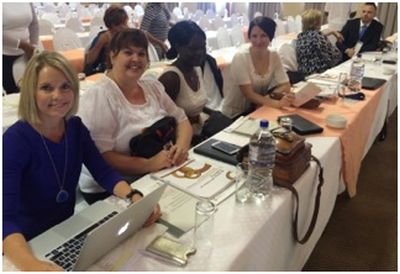 [notice]A monthly column by Marcel van der Watt, lecturer in the Department of Police Practice at UNISA, former police detective, and current member of the Gauteng Rapid Response Task Team for Human Trafficking.[/notice]
[notice]A monthly column by Marcel van der Watt, lecturer in the Department of Police Practice at UNISA, former police detective, and current member of the Gauteng Rapid Response Task Team for Human Trafficking.[/notice]
A round table discussion was facilitated by the Department of Social Development on Friday 20 February 2015 which focussed on strengthening the partnership between stakeholders in the fight against human trafficking, and sharing best practices in the prevention and combating of human trafficking in South Africa. The event, which took place at the St Georges Hotel and Conference Centre in Pretoria, was attended by a range of role-players which included government departments, NGOs and international representatives. The passion and dedication of those who participated to eradicate this heinous social ill was unequivocal. Delegates were greeted by a well organised registration process. Bustling conversations echoed through the foyer and conference hall of the St George’s Hotel as old friends, partners and colleagues from all nine provinces in South Africa connected and reconnected.

The choice of speakers at the roundtable event is definitely to be commended. They included representatives from the Albinism Society of South Africa (ASSA), the International Organization for Migration (IOM) and time-honoured ambassadors to the cause, Molo Songololo and Mercy House Shelter. Central to the discussions among stakeholders was to look at the implementation of the Prevention and Combating of Trafficking in Persons Act which was signed into law in July 2013. Notwithstanding the fact that the new Act is praised by many experts for its comprehensive approach to the wide-ranging crimes and issues associated with human trafficking, it remains to be implemented.
The very nature of the crime and multiplicity of issues that need to be responded to requires all government departments to be operationally intact. Furthermore, the transient nature and jurisdictional dynamics of a trafficking scenario demands coordination with NGOs for service provision and the prosecution of traffickers. This is evident in a US study by Stoll, Edwards and Mynatt (2010) who made reference to one case where 21 different organisations were enumerated that had to be involved in the identification, intervention and subsequent rescue of a 15-year old victim of sex trafficking. The roundtable discussion also highlighted the importance of improving the coordination of victim support services throughout the support spectrum and referral system. It is therefore of utmost importance that policies, directives and standing operating procedures convey the same message whilst doing so in the same organisational language.
Other recommendations that emerged from the round-table include:
- The fast-tracking of integrated information management systems between role players;
- While the Prevention and Combating of Trafficking in Persons Act has been signed into law, its operationalisation is dependent on regulations and national directives and instructions that are required to be made by a number of role-playing departments. The round-table therefore called for a rapid finalisation of these issues in order for the Act to be fully implemented;
- Continuous research must be conducted to avail data for better understanding of the human trafficking phenomenon. Research would also aide in capacity building of practitioners;
- Government must make sufficient resources available to fight human trafficking; and
- Programmes must emphasise prevention of human trafficking through public education initiatives.
Much criticism has been levelled against government on numerous occasions for the delay in actually finalising and implementing the Prevention & Combating of Trafficking in Persons Act. I vividly remember awaiting the “arrival” of the Act during my investigations into incidents of human trafficking in the years leading up to the 2010 World Cup – not imagining another 5 years would lapse before South Africa reap its fruits. However, deeper reflection caused me to think about our counter human trafficking journey since 2002 with some thoughts that came to mind:
- Were there at least some pieces of legislation that were responsive to cases of human trafficking? Yes indeed.
- Could the Act, policies, directives, awareness and training have been concluded in a shorter timespan? Definitely.
- Did all stakeholders and government departments fully appreciate the complexity of the crime 10 or even 5 years ago? No.
- Is an appreciation of this complexity necessary to frame contextually relevant policy and enforcement responses? Most definitely.

The lack of comprehensive research studies and, most importantly, the lack of local statistics related to the extent of the problem were once again highlighted at the roundtable discussion. These are but some of the ‘bread and butter’ considerations that fundamentally inform the drafting of Acts, policies and directives. Despite our counter human trafficking journey being less than perfect, and falling short of a Tier 1 Ranking in the US Department of State annual Trafficking in Persons (TIP) Report, a new chapter in this journey is about to be written and we should all be co-authors. The storyline is iterative, and the scars suffered by the protagonists do not dictate, but only remind them of the past; it infuses wisdom and solidifies characters and battle gear going forward. I am inspired by the countless people who dedicate their lives and careers to address this social ill. They include prosecutors, investigators, social workers, civil society and volunteers attached to the National Freedom Network to name but a few – all of them being everyday “coalface” heroes.
Finally, measures to combat human trafficking cannot be divorced from the numerous other structural issues that need to be addressed in South Africa. Issues such as racism, poverty, unemployment, education and inequality all interpenetrate at some point. Identifying and assisting victims of this crime is important, but so is the identification and response to the vulnerable communities on our doorsteps. The oft asked question “How many victims?” can, and should be rephrased as “How many vulnerable communities?” Nobody is exonerated from responding to the latter question and its concomitant responsibilities. The Act will soon be here and an exciting chapter is waiting to be written. Let’s be co-authors, and pick up a worthy cross to carry!
References
Stoll, J., Edwards, W.K. & Mynatt, E.D. 2010. Interorganizational Coordination and Awareness in a Nonprofit Ecosystem . Paper delivered at ACM Conference on Computer Supported Cooperative Work, February 6 – 10, Savannah, Georgia, U.S.A
Websites which reported on the abovementioned event:
http://www.southafrica.info/services/rights/trafficking-240215.htm
http://www.ann7.com/article/27447-20022015human-trafficking-on-agenda-in-pretoria.html
http://www.dsd.gov.za/index.php?option=com_content&task=view&id=674&Itemid=1






